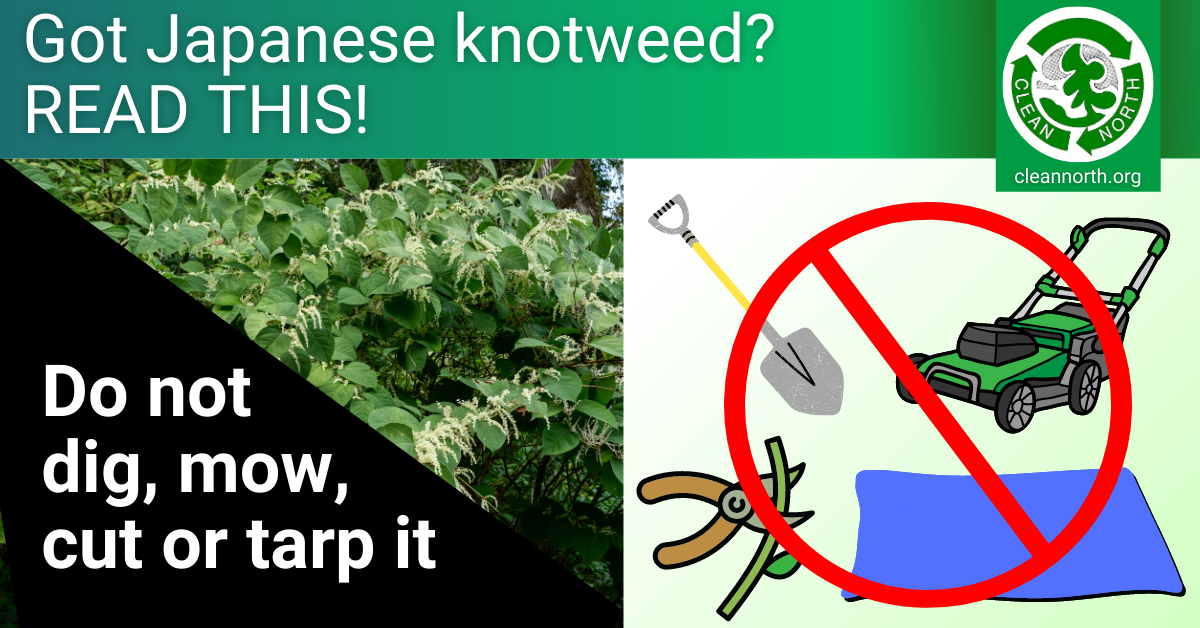
Japanese knotweed is one of the most damaging invasive species in Canada—but many websites are dispensing management advice that could make a bad invasion even worse. The best available science shows that digging, mowing, cutting, and/or tarping Japanese knotweed is not effective and can even stimulate massive expansion in this species’ root system. In fact, the only effective control method is applying glyphosate weedkiller, and it must be applied during a specific window in late summer.
Don’t underestimate Japanese knotweed
Japanese knotweed is one of the most resilient organisms on Earth. In fact, it can survive hot lava flows! Its roots, referred to as rhizomes, can grow more than 10 feet deep and 35 feet beyond where you see aboveground stems. It can stay dormant for more than 20 years, just waiting for an opportunity to pop up again.
The traditional physical methods of controlling invasive plants—cutting or mowing the tops off, digging plants out, and/or tarping—don’t work. In fact, disturbing knotweed can trigger exponential lateral root growth.
And if you cut, mow, or dig it out, you can start entire new stands if a tiny piece of root or stem gets tracked to a new location. Many new stands have cropped up because people cut or dug out knotweed and dumped it in a natural area. Moving soil that has bits of Japanese knotweed in it can also lead to new stands.
So what do I do if I have Japanese knotweed?
First, get a firm ID
Here is one in depth guide to identifying it.
Do not cut, mow, or dig it
Resist the urge to cut, mow, or dig Japanese knotweed. Any method other than applying glyphosate will likely stimulate this plant’s root system to go on a growing spree. Some who are experienced at dealing with Japanese knotweed refer to this as “awakening the dragon.”
Consider that:
If you cut, mow or dig this plant; bag it; and put it in the trash, it will likely start a new stand at the landfill. Even if you solarized the bags in the sun for a month first. Remember, this plant is adapted to lava flows! If you burn it in a firepit and miss a piece of root, you may end up with a new infestation in your firepit. It’s that persistent.
If Japanese knotweed is in your yard or that of a neighbour, think twice about sharing plants from your yard with friends or selling them. Roots hidden in soil are another common method of spread.
The herbicide route
If you are in Ontario and are determined to control your infestation, contact the local Ministry of Natural Resources and Forestry Office and ask for a letter of opinion, which will allow you to hire a licensed herbicide applicator. Keep in mind that glyphosate controls rather than eradicates Japanese knotweed. Eradication is nearly impossible.
“But aren’t herbicides illegal in Ontario?” It is illegal for homeowners to use herbicides for cosmetic purposes, for example, to kill dandelions because you don’t like the way they make your lawn look.
However, it is also illegal to own, buy, or sell Japanese knotweed, and it is considered one of the most damaging invasive plant species in Canada. Thus, you may be permitted to hire a licensed herbicide applicator to spray it.
FYI: Herbicides may be used without a permit when there is a threat to health and safety—blocked visibility at a road/intersection, potential threat to human health, fire hazard, threat to a building’s structural integrity (ONTARIO REGULATION 63/09, Herbicide Use and Regulations in Ontario.)
How damaging is Japanese knotweed?
Here in Sault Ste. Marie, Japanese knotweed is invading local natural areas and pushing out native plants. When native plants go, populations of native insects, birds, and other wildlife may also fall or disappear. It’s also starting to crop up in area forests and at people’s camps.
In the United Kingdom, Japanese knotweed is causing massive hassles for property owners. It’s not only taking over people’s land but also causing big dips in property values and making it harder for people to get a mortgage. It can also cause damage to foundations, walls, pathways, and drainage systems (both in the UK and here in Canada!). UK courts are now awarding damages for encroaching Japanese knotweed.
If we don’t want to end up like the UK, we need to take the Japanese knotweed problem seriously and do our best not to make it worse than it already is. Don’t trigger it to spread by mowing, cutting or digging it—or moving any plant parts to a new location.
Where can I learn more?
- Join the Worldwide Japanese Knotweed Support Group
- Read this 2018 scientific journal article, which documented that only glyphosate effectively controls Japanese knotweed
- Read a detailed Guardian article on Japanese knotweed
- Read this article on the most sustainable method of dealing with Japanese knotweed
Questions?
Email us at cleannorth.org.




